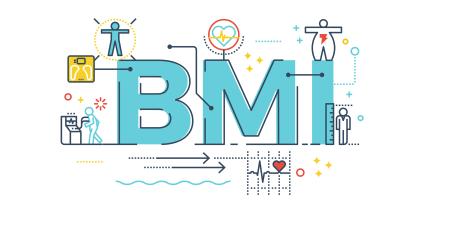About a third of Americans are obese and another third are overweight. The prevalence of obesity has been increasing over the last four decades and affects men and women of all ages, races, and ethnic groups [1]. Obesity is a major risk factor for numerous diseases and a major cause of disability and mortality; it affects quality of life and accounts for huge expense to the health care system [2].
A Brief History of the Diagnosis of Obesity
For decades, actuarial tables from the Metropolitan Life Insurance Company were used to estimate ideal weight and then determine the percentage of excess weight [3, 4]. Since the 1980s, the diagnosis of obesity has come to rely more on the use of the body mass index (BMI), defined as one’s weight in kilograms divided by the square of his or her height in meters. BMI is now the most common anthropometric method to diagnose obesity. The BMI was first described in the 19th century by a Belgian mathematician who noticed that, in people he considered to be “normal frame,” the weight was proportional to the height squared [5]. However, the BMI was not first used in epidemiologic studies until 1972 [6] and introduced in clinical practice more than a decade later.
In 1995, the World Health Organization defined obesity as a BMI equal to or greater than 30 (kilograms of weight per squared meter of height) based on a consensus of scientists and experts. This cutoff was selected because the mortality curve from many epidemiologic studies showed an upward inflection at this level, suggesting a threshold effect. The WHO also defined overweight as a BMI equal to or greater than 25 [7].
The Importance of Diagnosing Obesity
Regardless of the method used to diagnose obesity, there is overwhelming evidence of an association and, indeed, a causal relationship between obesity and many comorbidities and even mortality. Epidemiologic studies have demonstrated that obesity is a major risk factor for cardiovascular disease, hypertension, type 2 diabetes mellitus, degenerative joint disease, obstructive sleep apnea, dyslipidemia, gastroesophageal reflux disease, nonalcoholic fatty liver disease, and many forms of cancer. Obesity has also been associated with decreased survival, poor quality of life, low functional status, and disability. An accurate diagnosis of obesity prevents patients at risk due to excess adiposity from being erroneously labeled as “normal” and avoids labeling patients with no excess fat as overweight or obese.
Evidence suggests, moreover, that a doctor’s diagnosis of obesity may lead to weight loss [8]. In the study by Singh et al., people with coronary artery disease who reported receiving a diagnosis of obesity from a health care professional were more likely to have attempted and succeeded in weight loss than those who did not recall receiving such a diagnosis [9]. Other studies have shown similar results. Despite the major implications of obesity and the evidence suggesting that diagnosing obesity may encourage weight loss and weight-loss attempts, many individuals with BMI-defined obesity do not receive this diagnosis [10].
Limitations of BMI as a Diagnostic Tool
Several studies have compared using BMI calculations to detect body adiposity with techniques known to accurately measure body composition. The results of these studies have varied, but there is conclusive evidence that standard BMI cutoffs for obesity appear to underestimate body adiposity. A BMI equal to or greater than 30 has a sensitivity of 50 percent in detecting excess adiposity, meaning that half of those with a high body fat percent will not be called obese. Furthermore, because BMI calculations use total weight in the denominator, some lean subjects with preserved muscle mass may be labeled overweight. On the other hand, BMI does not take fat distribution into account, so people who are normal weight or slightly overweight but who have abnormal body fat distribution, and may therefore be at increased risk for cardiovascular events, type 2 diabetes mellitus, and overall mortality [11], will not be considered at risk by BMI criteria.
Measures of Central Obesity
Waist-to-hip ratios have been used as a proxy measure for body fat distribution in assessing the health consequences associated with obesity. Measures of central obesity very likely help refine the clinical evaluation of obesity-related risk [12]. “Central obesity” generally refers to abdominal deposition of fat, although investigators have suggested that it may also mean truncal or axial deposition of fat, which includes visceral adiposity and subcutaneous fat from the abdomen, thorax, and proximal segments of the upper extremities. Central obesity correlates well with excessive visceral fat, which appears to be the most metabolically active fat, causing insulin resistance, hypertriglyceridemia, small LDL particles, and low HDL levels, features considered pro-atherogenic [13, 14].
Different methods have been proposed for measuring waist circumference. Some include the perimeter of the abdominal wall above the upper edge of the iliac crest, others use the umbilicus as the reference point [15], and some investigators have used the largest abdominal circumference, regardless of its location [16]. All correlate well with the total amount of visceral fat in grams as measured by more accurate techniques like abdominal CT or magnetic resonance. The hip circumference is measured at the level of the major trochanters or the largest circumference at the level of the buttocks. Standard cutoffs to define central obesity are listed in table 1.
Table 1. Diagnostic criteria for obesity and central obesity
|
Obesity by body mass index |
|
|
Category |
BMI |
|
Underweight |
18.5 or less |
|
Normal weight |
18.5-24.9 |
|
Overweight |
25-29.9 |
|
Obesity class I |
30-34.9 |
|
Obesity class II |
at least 35 |
|
Central obesity by waist circumference† |
|
|
Population |
Cutoff (cm) |
|
American men* |
at least 102 (40 in) |
|
American women* |
at least 88 (35 in) |
|
Asian men |
at least 90 (35 in) |
|
Asian women |
at least 80 (32 in) |
|
Central obesity by waist-to-hip ratio |
|
|
Population |
Cutoff |
|
Men |
more than 0.90 |
|
Women |
more than 0.85 |
|
†Note: Cutoffs recommended for other groups: for the Japanese population, the Japanese Obesity Society suggests at least 85cm for men and at least 90cm for women; the Cooperative Task Force suggests at least 85cm for Chinese men and at least 80cm for Chinese women; IDF suggests at least 94cm for men and at least 80cm for women for Middle Eastern, Mediterranean and Sub-Saharan populations, and at least 90cm for men and 80cm for women for ethnic Central and South American populations. *According to AHA/NHLBI (ATPIII); although those cutoffs are recommended for Caucasian individuals, there is no strong evidence supporting the use of different values for Hispanic Americans, African Americans or Native Americans. |
|
The diagnosis of central obesity has several limitations. It is not clear whether waist-to-hip ratio provides more prognostic information than measuring waist circumference alone, and there is controversy about which of the two measurements has the stronger association with mortality, incidental diabetes, or cardiovascular disease. The waist-circumference measurement has shown a fair reproducibility in research studies, but the variability can be significant in clinical practice. The existence of multiple ways to measure waist is also a source of inconsistencies.
Body Fat Content
Despite the fact that the word “obesity” is defined as excessive adiposity, there has never been a formal attempt to diagnose obesity in clinical practice based on direct or indirect measurements of body fat; there is no consensus on what percent of body fat is normal and what percent is abnormal. Investigators in the field generally identify excessive adiposity as more than 30 or 35 percent body fat for women and more than 20 or 25 percent for men.
The methods of calculating body fat composition—specifically body fat percentage and lean mass content—have been traditionally considered either too complex (e.g., water immersion plethysmography, isotope dilution techniques) or inaccurate (e.g., the skinfold method, body impedance measured with over-the-counter scales). But other methods like DEXA (dual energy X-ray absorptiometry), multi-frequency bioimpedance, and air displacement plethysmography are relatively simple, reproducible and valid. Although there is limited data about usage of these methods in health care centers, it appears that only a minority of medical institutions use them in clinical practice [17].
Normal Weight Obesity
Recent reports have suggested that individuals with normal body weight as defined by BMI might still be at risk for metabolic syndrome, cardiometabolic dysregulation, and even increased mortality. A recent study demonstrated that men of normal weight in the upper tertile of body fat percentage (more than 23 percent fat) were four times more likely to have metabolic syndrome and had a higher prevalence of diabetes mellitus, hypertension, dyslipidemia, and cardiovascular disease than those in the lowest tertile [18]. Women in the highest tertile of body fat (more than 33 percent of body weight) were seven times more likely to have metabolic syndrome. Interestingly, women with normal weight obesity were almost twice as likely to have died at follow-up than women in the lowest tertile of body fat. These associations were not explained by the slightly higher prevalence of these risks among men and women with central obesity. Although further research is needed to clarify these results, it is clear that subjects with normal weight as defined by BMI may need more detailed classification to better define their adiposity-related risk.
Proposed Algorithm for Diagnosing Obesity
Figure 1 shows an algorithm for diagnosing obesity based on the best scientific evidence. Although BMI has several limitations, its simplicity and good specificity guarantees the universal measurement of BMI as the first step in screening for obesity. Because at least 90 percent of people with BMIs equal to or greater than 30 have excess adiposity, and at least 95 percent of them have an enlarged waist circumference, most individuals with a BMI equal to or greater than 30 can be diagnosed as obese, with no further measurement necessary [19]. The only exceptions are bodybuilders and professional or extreme athletes, who may have large amounts of muscle mass. Individuals with a BMI less than 18.5 will be diagnosed as underweight, and clinicians should rule out chronic wasting conditions, anorexia nervosa, malnutrition, or fragility. Those individuals have a mortality risk even higher than subjects with a BMI equal to or greater than 30 [20].
Because individuals who are normal weight or overweight might have abnormal fat distribution or high body fat percentages that increase their risk for metabolic dysregulation and mortality, we recommend additional steps to better stratify their adiposity-related risk. The steps displayed in figure 1 for people with a BMI between 18.5 and 29 are meant to identify individuals with either central obesity or normal weight obesity. If BMI falls into this range, the next step is to determine if they have central obesity or excess fat by direct fat percentage calculation. Individuals with central obesity or increased adiposity despite a BMI below the obesity cutoff should be strongly encouraged to make changes in their food choices and level of physical activity. Subjects with normal weight obesity, who tend to have low percentages of lean mass, might improve their body composition through strength or resistance training. The steps in figure 1 can also identify individuals who are lean and should not be labeled “pre-obese.”
Conclusions
A diagnosis of obesity might be the first step toward initiating behavioral changes leading to weight loss. BMI is the most widely used method of diagnosing obesity, and it is effective, but it is also important to identify subjects with central obesity or increased total body fat percentage, particularly among those with normal or mildly elevated BMIs, and to avoid misclassifying people without any obesity-related risk as overweight or obese. A complete assessment of adiposity-related risk appears to be as important as many other elements of clinical practice.
References
- Flegal KM, Carroll MD, Kuczmarski RJ, Johnson CL. Overweight and obesity in the United States: prevalence and trends, 1960-1994. Int J Obes Relat Metab Disord. 1998;22(1):39-47.
- Colditz GA. Economic costs of obesity. Am J Clin Nutr. 1992;55(2 Suppl):503S-507S.
-
Metropolitan Life Insurance Company.Overweight: its prevention and significance. Stat Bull Metropol Life Insur Co. 1960;41:6.
-
Stewart AL, Brook RH. Overweight. Santa Monica, CA: Rand Corporation; 1980. Conceptualization and Measurement of Health Habits for Adults in the Health Insurance Study; vol 2.
-
Quetelet LAJ. A Treatise on Man and the Development of His Faculties. New York: Burt Franklin; 1968.
- Keys A, Fidanza F, Karvonen MJ, et al. Indices of relative weight and obesity. J Chronic Dis. 1972;25(6):329-343.
-
Physical status: the use and interpretation of anthropometry. Report of a WHO Expert Committee. World Health Organ Tech Rep Ser. 1995;854:1-452.
- Loureiro ML, Nayga RM Jr. Obesity, weight loss, and physician's advice. Soc Sci Med. 2006;62(10):2458-2468.
-
Singh S, Somers VK, Clark MM, et al. Physician diagnosis of overweight predicts weight loss attempts in patients with cardiovascular disease and central obesity. Circulation. 2008;118(18 Suppl 2):S1091.
- Bardia A, Holtan SG, Slezak JM, Thompson WG. Diagnosis of obesity by primary care physicians and impact on obesity management. Mayo Clin Proc. 2007;82(8):927-932.
- Pischon T, Boeing H, Hoffmann K, et al. General and abdominal adiposity and risk of death in Europe. N Engl J Med. 2008;359(20):2105-2120.
-
Poirier P. Cardiologists and abdominal obesity: lost in translation? Heart. 2009;95(13):1033-1035.
- Despres JP, Lemieux I. Abdominal obesity and metabolic syndrome. Nature. 2006;444(7121):881-887.
- Navab M, Anantharamaiah GM, Fogelman AM. The role of high-density lipoprotein in inflammation. Trends Cardiovasc Med. 2005;15(4):158-161.
- Hu FB, Willett WC, Li T, et al. Adiposity as compared with physical activity in predicting mortality among women. N Engl J Med. 2004;351(26):2694-2703.
- Nicklas BJ, Penninx BW, Cesari M, et al. Association of visceral adipose tissue with incident myocardial infarction in older men and women: the Health, Aging and Body Composition Study. Am J Epidemiol. 2004;160(8):741-749.
- Fogelholm M, van Marken Lichtenbelt W. Comparison of body composition methods: a literature analysis. Eur J Clin Nutr. 1997;51(8):495-503.
- Romero-Corral A, Somers VK, Sierra-Johnson J, et al. Normal weight obesity: a risk factor for cardiometabolic dysregulation and cardiovascular mortality. Eur Heart J. 2010;31(6):737-746.
- Freiberg MS, Pencina MJ, D'Agostino RB, et al. BMI vs. waist circumference for identifying vascular risk. Obesity (Silver Spring). 2008;16(2):463-469.
- Whitlock G, Lewington S, Sherliker P, et al. Body-mass index and cause-specific mortality in 900,000 adults: collaborative analyses of 57 prospective studies. Lancet. 2009;373(9669):1083-1096.



